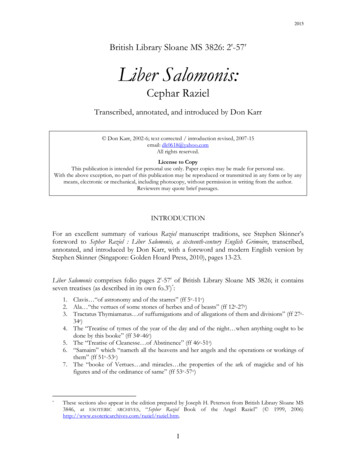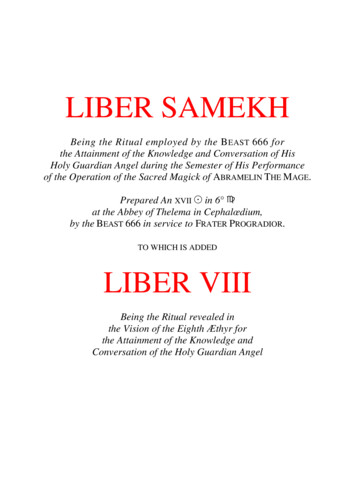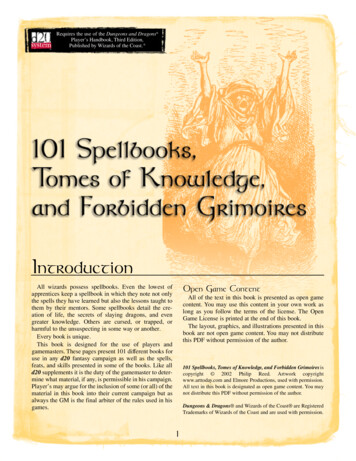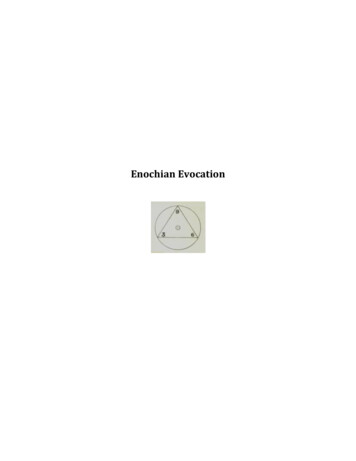
Transcription
2015British Library Sloane MS 3826: 2r-57rLiber Salomonis:Cephar RazielTranscribed, annotated, and introduced by Don Karr Don Karr, 2002-6; text corrected / introduction revised, 2007-15email: dk0618@yahoo.comAll rights reserved.License to CopyThis publication is intended for personal use only. Paper copies may be made for personal use.With the above exception, no part of this publication may be reproduced or transmitted in any form or by anymeans, electronic or mechanical, including photocopy, without permission in writing from the author.Reviewers may quote brief passages.INTRODUCTIONFor an excellent summary of various Raziel manuscript traditions, see Stephen Skinner‘sforeword to Sepher Raziel : Liber Salomonis, a sixteenth-century English Grimoire, transcribed,annotated, and introduced by Don Karr, with a foreword and modern English version byStephen Skinner (Singapore: Golden Hoard Press, 2010), pages 13-23.Liber Salomonis comprises folio pages 2r-57r of British Library Sloane MS 3826; it containsseven treatises (as described in its own fo.3r)*:1. Clavis ―of astronomy and of the starres‖ (ff 5v-11v)2. Ala ―the vertues of some stones of herbes and of beasts‖ (ff 12r-27r)3. Tractatus Thymiamatus of suffumigations and of allegations of them and divisions‖ (ff 27r34r)4. The ―Treatise of tymes of the year of the day and of the night when anything ought to bedone by this booke‖ (ff 34r-46r)5. The ―Treatise of Cleanesse of Abstinence‖ (ff 46r-51r)6. ―Samaim‖ which ―nameth all the heavens and her angels and the operations or workings ofthem‖ (ff 51v-53v)7. The ―booke of Vertues and miracles the properties of the ark of magicke and of hisfigures and of the ordinance of same‖ (ff 53v-57v)*These sections also appear in the edition prepared by Joseph H. Peterson from British Library Sloane MS3846, at ESOTERIC ARCHIVES, ―Sepher Raziel Book of the Angel Raziel‖ ( 1999, .htm.1
2015Liber Salomonis refers to itself as ―Cephar Raziel‖ (ff 2v, 3r, 4r, 12r, 34r), ―Sephar Raziel‖ (fo.2r), ―booke of Raziel‖ (ff 20r, 46r, 57r), and ―booke of Razeelus‖ (fo. 3v). Solomon isindicated as the recipient and redactor—not the author—of the book in the narrative whichintroduces the text (ff 2v-3v), though most instructions begin, ―Salomon said .‖ Othersbegin, ―Hermes said ‖ (ff 9r, 11r, 18v, 24r, 28v, 30r, 31r, 32r, 33v), ―Adam said ‖ (fo. 16r),―Nathaniel said ‖ (fo. 47r), ―Moyses said ‖ (ff 4r, 4v), and ―Raziel said ‖ (ff 6r, 16v, 22r,26r, 28v, 31v, 34v, 36r, 37r, 38v). Narrative passages refer to Raziel as the source of the book(e.g., ff 34r and 36r).The rest of Sloane MS 3826 consists of1.2.3.4.5.6.7.8.Incipit Canon: The rule of the book of consecration, or the manner of working (ff 58r-60r)Orisons (ff 60r-65r)Magical directions (ff 65r-83v)Liber Lunæ (ff 84r-97v)Raphael: The Invocation of Oberon Concerning Physick &c (ff 98r-99r)The Call of Bilgal, One of the 7 etc. (fo. 99v)An Experiment for a Fayry (fo. 100r)Beleemus De imaginibus (ff 100v-101r)Sloane MS 3826 is in English, except for(i)(ii)(iii)(iv)the opening lines of paragraphs in Liber Salomonis and Incipit Canonthe Orisonsthe invocation, constriction, ligation, and license of RaphaelBeleemus De imaginibus (BELEEMUS REGARDING THE IMAGES [OF THE PLANETS])In various papers and communications, I have expressed the opinion that Sloane 3826 was asixteenth-century Christian product, though one which borrowed from Jewish, Arabic, andGræco-Roman scholastic and folk sources. In a note to me (January 28, 2007), Sophie Pageoffered an informed and most welcome emendation to my view in the form of an abridgedsegment from her article, ―Uplifting Souls and Speaking with Spirits: The Liber de essentiaspirituum and the Liber Razielis,‖ which was to be published in Claire Fanger (ed.), InvokingAngels: Mystical Technologies in the Middle Ages †:The most explicit transmission of Jewish magical material into the Christian Latin tradition ofmagic was the translation of works associated with the name ―Raziel,‖ an angel present in Jewishangelology and Arabic astrological texts who was said to have revealed a book of secrets toAdam. Various esoteric and magical treatises attributed to Raziel and based on the practical useof divine and angelic names circulated among late medieval Jews. The earliest known reference inLatin is a citation by the Christian convert Petrus Alfonsus [OR Alfonsi] (1062-1110) of a certainSecretum secretorum, which claimed to have been revealed to Seth, the son of Adam, by the angelRaziel. By the mid-thirteenth century, these magic texts were circulating more widely in Latin. In1259, Alfonso [X, (1221-1284)] directed the translation of a work entitled Liber Razielis fromLatin into Castilian by the cleric Juan d‘Aspa. The Castilian version does not survive, but theLatin original put together by Alfonso survives in two complete and several partial copies, as well†This was actually published as Invoking Angels: Theurgic Ideas and Practices, Thirteenth to Sixteenth Centuries,edited by Claire Fanger (University Park: The Pennsylvania State University Press, 2012). The passagequoted, with significant additions and modifications, occurs on pages 81-83.2
2015as various early modern abridged vernacular versions. The Alfonsine Liber Razielis is structured inthe form of seven books said to have been brought together by Solomon. Nine related textsfrom the Solomonic and Hermetic magical traditions were added by Alfonso‘s scribes asappendices. Although the preface cites a single Hebrew original for the seven volumes, it is likelythat the structure was partly a creation of Alfonso himself and his translators.The following post-1500 manuscripts contain abridged vernacular copies of the Alfonsine LiberRazielis or the Liber Sameyn only (the sixth book). This is not an exhaustive list, and I have onlypersonally examined those in the British Library: MS Yale, Beinecke Rare Books Library OsbornMS fa. 7 (late s. xvi, English); British Library MSS Sloane 3826 (s. xvii, English), ff. 1-57, Sloane3846 (s. xvi, English), ff 127-55; MS Lyon 970 (s. xvii, xviii, French; MSS Alnwick Castle 596 (s.xviii, Italian, the Liber Sameyn), pp. 1-42 and 96 (Italian, Latin, English, the Liber Sameyn only); MSLübeck, Bibliothek der Hansestadt, Math. 4o 10 (s. xvi/xvii, German); MS Dresden N. 36 (s.xviii, German); Prague, National Museum Library MS XVIIF25 (1595, Czech, trans. IoannesPolenarius). MS British Library Add. 16, 390 (s. xvii) has a Hebrew extract with a title in Italian.Where no folio references are given, the catalogue entry suggests that the Liber Razielis travelsalone.Suggested bibliography: J. Dan, ―Raziel, Book of,‖ Encyclopedia Judaica 13 (Jerusalem, 1971), 159293; A. Garcia Avilés, ―Alfonso X y el Liber Razielis: imagines de la magia astral judía en elscriptorius Alfonsi,‖ in Bulletin of Hispanic Studies, Volume 74, Number 1: January 1997, pp. 21-39(Carfax Publishing/Liverpool University Press); Alfonso d‘Agostino, Astromagia [MS. Reg. Lat1283a] (Naples: Liguore, 1992). On the later fortuna of the Liber Razielis in Spain and elsewhere: F.Secret, ―Sur quelques traductions du Sefer Raziel,‖ Revue des études Juives, 128 (Paris: 1969), pp.223-45. On magic at the Alfonsine court, see also N. Weill-Parot, Les images astrologiques au MoyenÂge et a la Renaissance (Paris: Honor Champion, 2002), pp. 123-138.[my brackets—DK]In her introduction to The Watkins Dictionary of Angels (London: Watkins Publishing, 2006),Julia Cresswell writes (page 9) of Sloane 3826,I would suggest that although the manuscript may be sixteenth century, some of the language israther old-fashioned for that date, except perhaps for an old person writing in the early sixteenthcentury. I would guess that the text is a reworking if an earlier one, pushing the origin of thematerial back into the Middle Ages.Liber Salomonis is here literally transcribed, line-by-line; no changes in spelling or wordinghave been made. (Spelling in the MS is quite inconsistent; e.g., within a few lines of eachother, we find ―wing,‖ ―winge,‖ ―wyng,‖ and ―wynge.‖) With the superscript and otherfeatures, I have imitated the look of the text. Note that superscripted letters belong to thetext; superscripted numbers refer to footnotes. All Latin headings are in italics. Each page oftext here represents a folio page of the MS; folio numbers are given in square brackets.3
2015Printed notices of Sepher Raziel and Sloane MS 3826 Alchemy Web Site, ―organised by Adam McLean.‖ ―Sepher Raziel Manuscripts,‖ on-lineat http://www.alchemywebsite.com/raziel.html; also in print as an appendix to SteveSavedow‘s Sepher Rezial Hemelach: The Book of the Angel Rezial, York Beach: SamuelWeiser, Inc., 2000.Åkerman, Susanna. ―Queen Christina‘s Latin Sefer-ha-Raziel Manuscript,‖ in JudaeoChristian Intellectual Culture in the Seventeenth Century: A Celebration of the Library of NarcissusMarsh (1638-1713), [INTERNATIONAL ARCHIVES, 163] edited by Allison P. Coudert,Sarah Hutton, Richard H. Popkin, and Gordon M, Weiner (Dordrecht: KluwerAcademic Publishers, 1999), pages 20 and 25, note 25.Cresswell, Julia. The Watkins Dictionary of Angels, London: Watkins Publishing, 2006.Cresswell uses my original online version of Sloane 3826 (at Esoterica, Volume V html, l )‡as her ―base text‖ in compiling this grand list of ―angels and angelic beings.‖Harrison, Peter. The Fall of Man and the Foundations of Science, Cambridge: CambridgeUniversity Press, 2009, page 18.Karr, Don; and Nachshon, Calanit. Liber Lunæ: Book of the Moon, Sepher ha-Levanah, witha foreword by Stephen Skinner. [SOURCEWORKS OF CEREMONIAL MAGIC, volume 7].Singapore: Golden Hoard Press, 2011.Karr, Don; and Skinner, Stephen. Sepher Raziel also known as Liber Salomonis, a 1564English Grimoire from Sloane MS 3826. [SOURCEWORKS OF CEREMONIAL MAGIC, volume6]. Singapore: Golden Hoard Press, 2010.Klaassen, Frank F. RELIGION, SCIENCE, AND THE TRANSFORMATIONS OF MAGIC:MANUSCRIPTS OF MAGIC 1300-1600. Ph.D. dissertation: Toronto: University ofToronto, 1999: page 133 (ref. Liber sacer i.e., ―Honorius material‖), page 207 (as anexample of a seventeenth-century collection combining ritual and scholastic imagemagic), page 259 (listed under ―Seventeenth Century [MSS]‖).Láng, Benedek. Unlocked Book: Manuscripts of Learned Magic in the Medieval Libraries ofCentral Europe [MAGIC IN HISTORY SERIES]. University Park: The Pennsylvania StateUniversity Press, 2008, page 91, note 21.Maddison, Francis, and Turner, Anthony. ―The Names and Faces of the Hours,‖ inBetween Demonstration and Imagination: Essays in the History of Science and Philosophy Presentedto John D. North, edited by Lodi Nauta and Arjo Vanderjagt (Leiden: Brill, 1999), pages143-4: Table 18 and Table 19.Mathiesen, Robert. ―A Thirteenth-Century Ritual to Attain the Beatific Vision fromthe Sworn Book of Honorius of Thebes,‖ in Conjuring Spirits: Texts and Traditions ofMedieval Ritual Magic, edited by Claire Fanger. University Park: Pennsylvania State ‡Esoterica (journal) http://www.esoteric.msu.edu/: online volumes I-VII, editor-in-chief Arthur Versluis, (East Lansing: Michigan State University, 1999-2005)download volumes VIII & IX (2006-2007)print Volumes [STUDIES IN ESOTERICISM]: Esotericism, Art, and Imagination, edited by Arthur Versluis, Lee Irwin,John Richards, and Melinda Weinstein (East Lansing: Michgan State University Press, 2008), and Esotericism,Religion, and Nature, edited by Arthur Versluis, Claire Fanger, Lee Irwin, and Melinda Phillips (East Lansing:Michgan State University Press, 2009).4
2015 University Press, 1998: page 145 (Sloane 3826 ff. 58-83 is listed as a MS of the SwornBook of Honorius).―M. Plessner, article on ‗Balinus‘ in Encyclopedia of Islam (new edn.1959) I, page 995.‖(This entry appears on the British Library reference form which accompanies themicrofilm version of the MS from which the current transcription has been done.)Page, Sophie. ―Uplifting Souls: The Liber de essential spirituum and the Liber Razielis,‖ inInvoking Angels: Theurgic Ideas and Practices, Thirteenth to Sixteenth Centuries, edited by ClaireFanger (University Park: The Pennsylvania State University Press, 2012.Peterson, Joseph H. ―Sepher Raziel (Sl. 3846) Book of the Angel Raziel‖ (edited by 1999, 2006) at ESOTERIC iel.htm.Shah, Idries. Oriental Magic. New York: E.P. Dutton & Co., 1956; rpt 1973: page 191,BIBLIOGRAPHY, Grimoire References, Chaldea: ―The following ‗Black Books‘ of thesorcerers have traces of Chaldean magical rituals or processes attributed to Chaldeanorigin: Sefer Raziel (The Book of Raziel). B.M. Sloane 3826.‖Shah, Idries. The Secret Lore of Magic. Secaucus: Citadel Press Inc., 1958: pages 288, 289,290, and 310; ref. abbreviation (SR).Thorndike, Lynn. History of Magic and Experimental Sciences, volume II: THE FIRSTTHIRTEEN CENTURIES. New York: Columbia University Press 1923: page 281.Waite, Arthur Edward. Book of Black Magic and of Pacts. London: Redway, 1898; rpt.New York: Samuel Weiser, Inc., 1972; pages 33-4 of the Weiser edition.Waite, Arthur Edward. The Book of Ceremonial Magic. London: Rider, 1911; rpt. NewYork: Bell Publishing Company, 1969: pages 20-21 and 22 of the Bell edition. (TheBook of Ceremonial Magic is a revised version of Book of Black Magic and of Pacts.)5
2015Liber Salomonis[2r]In noie Dei potentis vibi et veri et æterni &cIn the name of Almighty God living and very and ever lasting and wthout all and wch is said Adonay SadayEhye Asereye I begin to write this booke wch is saidSephar Raziel wth all his appertenances in wch be seventreatises complete or fulfilled that is vii bookes.Dixit Salomon Gloria et laus et cu multo honore &cSalomon said glory and praysing wth much honor be toGod of all Creatures, he that is singular wch made allthings at one tyme. And he is one God very mightyhe alone that is and that was and wch evermoreshall be, and wch has never an end or any like himneither is he like to have. And he is singular wthoutend, Lord alone wthout corruption, holy cleane meekeand great all things seeing and hearing and wise andin all things mighty. And I begin this booke to putan ynsample that whosoever that hath it blame it nottill he have red and heard all or somewhat of it, andthen prayse the God maker of all things.These be the ix precepts Incipiunt præceptaHeere beginneth the precepts1.2.3.4.5.Ne credas esse plures nisi unu singulare &cNe trowe thou no to be mo[r]e or many but one singularalone upon all things wch hath none like him and himlove wth all dread and honor wth all trust and wth goodwill and stable and wth might and wth all they cleaneheart. Ne live thou not wthout lawe, and thou shallbe loved of God thy creator and of folks. Ne do thounot to another man yf thou wouldest not the same. Nebe thou not a lyer to the Lord neither to thy friendand say thou such soothes that be to thy profit and notharme. Ne love thou not neither fellowship thou morewth unwise men then wth wisemen. And evermore love6
2015[2v]6.7.8.9.thou many wisdoms and good sciences and all thy willand thy lyfe in them. Ne speakest thou not before thouhave thought, and that thou do consider it in thinehart ere thou do it. Neither discover thou not thy privityesto a woman, neither to a childe, neither to a foole, neitherto a dronke woman. No prove thou not a medicine neithervenym in thy self before thou provest it in an other. Neblame thou not a booke before thou prophesy neither a wiseman till thou have proved thou. And if thou wth holdestthese ix precepts in thee evermore thou shalt profite moreand more. Postqua sensus et scire et posse vo luntas vera &c After that witt and knowledge andmight and very will overcometh all things wth good wittand good discretion. Therfore I will expound or make openhis booke wch is of great power and of great vertue.I, Salomon put such knowledge and such a distinctionand explanation in this booke to every man that readeth orstudyeth in it, that he may knowe whereof he was andfrom whome he came. Knowe ye that after I Salomonhad xxx yeeres wthin an half in the vth day of themonth of Hebreys wch was the vith ferial day, thesonne being in the signe of Leonis. In that day was sentto me from Babilony of some prince that was greaterand more worshipfuller then all men of this tyme somebooke that is said Cephar Raziel wch cont vii bookes andvii treatises.Nota tempus in quo Salomon fuit po adeptus istu libreet quomodo et a quo venit sibiKnowe thou the tyme in wch Salomon gott the booke andhowe and of whom it came to him.Iste liber est magnæ virtutis et magnæ secretiæ Thisbooke is of great vertue and of great privity, the name of theprince that sent it to me was Sameton and of the twowise men that brought it to me was said Kamazan andthe other Zazont.7
2015[3r]1.2.3.4.5.6.7.The name of this booke expounded in Latine is Angelus magnus Secreti Creatoris That is to say the great Angelof the secret creator And in Hebrew Cephar Raziel itis the booke after Adam written in language of Caldeyand afterward translated in Hebrew. And know each man thatreades it that in it all Semiforax that is to say the greatname complete wth all his names whole and even. and wthhis vertues and his sacraments And I found it in 7 bookes thatis 7 treatises. And know ye that I found the first and thelast full darke and the five middle more plain and althoughI found them darke I opened them as much as I could ormight. And the 7 treatises of this booke be these.The first is said Clavis for that in it is determined ofAstronomy and of the stares for wthout them we may donothing.The second is said Ala for that in it is determined of thevertues of some stones of herbes and of beastsThe third is said Tractatus Thymiamatus for thatthere is determined in it of suffumigations and of Allegations of them and divisionsThe ivth is said the Treatise of tymes of the year of theday and of the night for that in it is determined when anything ought to be done by this bookeThe vth is said the Treatise of Cleanesse for that thereis determined in it of AbstinenceThe sixth is said Samaim for in that treatise it namethall the heavens and her angels and the operations orworkings of themThe viith is the booke of Vertues for that there is determined in it of vertues and miracles for there be toldthe properties of the ark of magicke and of his figuresand of the ordinance of same.And the I beganne to write all these treatises in anewe volume for that one treatise wthout another servesnot to the wholeness of the worke Therfore I made an8
2015[3v]whole booke to be made of the treatises. Therfore Salomon said to his writer Clarifaton that he could writeit, wch I know well the language of Caldy of Indy of Hebrew and of Syne and their right explanation. MethelisSalomon said that after Clarifaton had corrected it andhad dressed it, it should be the better and ordained it inthe best maner that he might. And Clarifaton said, wchwas the writer of Salomon, that this booke is full ofgreat privity and that it was sent of full great honorAnd that it was sent to Salomon for most price andmost love. And everiche treatise of these vii waswas written by themselves. But although it be so thatClarifaton said that it ought to be but one booke aloneby itself for none of these saith he should suffice wthoutanother, wherefore he said it were necessary that theywere all together Whereupon Salomon ordained thatall the said 7 treatises were but one booke as theyought to be and as they ought to be read and wrought.And he ordayned it much better then the philo[soph][e]rs orday ned, and also he taught how a man ought to do hisworke by it. And he put every treatise by itselfand every chapter by itself and ordayned all tillthe end of the booke. And he putt into this booke Semiforasthat is the booke of 17 vertues how it ought to be writtenand of wch Inke, and of wch parchment and wth what penand wth what man, and in wch time and what day andin what night and in what hour. After that Salomonexpounded in the booke of Razeelus and how it ought tobe kept Cleanly and wth great honorDixit Salomon qui videt et non cognoscit &cSalomon said who so seeth and knoweth not is as hethat is borne blinde and knoweth not colors and whothat heareth and understandeth not is such as if hewere a deafe man. And who so considereth and knowethnot the consideration is such as if it were of a dronkerd9
2015[4r]And whom that speaketh and cannot expound the reason isas a dombe man. And who that readeth playne bookesand understandeth them not is as it were he dreameth.These proverbs Salomon said in this booke ffor as Salomonsaid in this booke is hit that Cephar Raziel the angelsaid to Adam wch was the first man in this world andafter it wch Moyses said to other prophets in soothesand we troweth it so.Dixit angelus Salomoni vt operes tuæ operationes &cThe angel said to Salomon that all thy workhings andpetitions and willes be fulfilled, and it shall be madein all hitt that thou shalt covet that it be in thy mightIt behoveth that when thou hast this booke of this or ofAnother example or ensample that thou write it inInst maner in virgin parchemt and that it be not filthyneither of a dead beast or in vealime (vitulino) or inparchmyn of sylke, or in samatyne1, or in cleane clotheor in parchmyn of a lamb or of a virgin kidde or of avirgin ffawne, and this is better than any other.And the Inke wth wch thou shalt write be it of cleanegalles and let it be made wth good white wyne & wholeand wth gume and vitriol and masticke & thyme andcroco. And the third day when it hath taken residenceand shall be clensed putt2 thou therein a little of Algabaand Almea3, and putt therein of good muske or muske morethan of those three. And put thou therein Amber and Balsamus myrryam and lignus aloes and when the Inkeshall be made, boyled wth masticke and wth thyme and wthlingo aloes and wth somewhat of Thymiamat and Muculazarat and thou clense it well wth a cleane thinneclothe, and the cloth be it threefold. And afterward putttherein muske and Ambram and Almenus & Alganaand Balsamis and Myrrhas all well grounden & then1Above ―samatyne‖ is written ―sattin.‖Above ―putt‖ is written ―& strained.‖3A marginal note offers an alternative to Almea: Alinza.210
2015[4v]shalt meddle all this wth the Inke full well togetherAnd let the inke be so still for the space of 3 days wellcovered in a fayre place And knowe thou that wth thisynke thou shalt write all the holy names of God andof his angels and of his saints, and all things in wchhis holy great name is4 nempned and written. And allthings that thou willest truly to be fulfilled wth thy wellpleasing or wth thy service. And what ere thou puttestin this ynke, be it newe and bright and pure and goodpen And the penne that thou shalt write the holy namesbe it of a greene reede gathered early ere the sunne5arise. And he that shall gather it be he clene & washen& in running water or in a quicke well and also lethim be clothed wth cleane clothes, and the moone beingwaxing wth Caput Draconis or wth Jove, for thatthey be true and very. And when thou shalt gather it, thoushalt behold of looke toward the East and thou shalt saythus Adonai et Saday jubate me ad complendus voluntates meas eos axundine ista. That is to say Helpye me to fulfill my willes wth this reede. and when thisis said thou shalt cutt one reede or twayne or as manyas thou wilt wth one stroke. And as Moyses said the knifebe it well playne sharpe and whole as thoughe we shouldcutt of an necke wth it. And thou take the reede wth thycleane hands, and make thou of it a gobbets. And when thouwilt cutt the penne, cutt it ere the sunne arise or whenit ariseth. With this penne and wth this ynke thou shaltwrite all the names of God holy and severall. And asoften as thou writest the name of the Creator be thoucleane and6 solleme & serened & in a cleane place. Andthou shalt first ere thou write by iii dayes be bathed incleane water, but rather thou shalt be cleane by 9 daysan house or cleane place made very cleane wth beesoms4Above ―is nempned‖ is written ―named.‖A marginal note here reads:it might be done / in the new of / the whiles / the dothe / increase when /she applieth / to caput dra / conis by o— / or to the o— of or / [fire] of[Jupiter]for if / they be true / & very good[ the moon ]6Above ―and solleme‖ (and in the margin) is written ―solitarie.‖511
2015[5r]and washen watered and suffumed And ordeyne so that whenthou writeth, hold thou thy face toward the East & write thoufrom morning till midday till that thou eate. And after thatthou hast eaten and dronken thou shalt not write in it anything. And if thou wilt write Semiforax wth his strengthesthe number of the mone, be it even. And most in the day of themone or of morning or of Jovis or dius. & be thou word ofSaturne and of Sol upon all. And Salomon said If thouputtest into the ynke of the bloud of vowter or of a turtur orof a gander (wholly or all white) the ynke shall be much thebetter and the more vertueAlso I say that if there were of Sapher powdered Sma ragdo, gagnisia & topasia the ynke shall be complete orfulfilled. And wth this Inke and wth this penne ought to bewritten all the names of Semiforas and knowe thou ythe that shall write this booke ought to be cleane & fastingbathed and suffumed wth precious aromatickes, that is wthspices well smelling. And it shall be great profit to theeand to him that maketh it or writeth it. And each man ythath written this booke or hath holden it in his house, ev‘moreholde he God in his mynde and his holy Angels & hitfor wch he hath made it. & let him put in his mynde inwch tyme of the 4 tymes of the day wth his ougth or ofthe tymes of an hower And ev‘more let him put inhis mynde to his 4 tymes of an hower to wch they oughtto be as invenies in libro propharumDixit Salomon sicut si esset castrum etcSalomon said as though there were a castle fullstrong and his highenes ful great and high and en hansed and well on each side wth walles invironed andthe gates in one place well strong and stable or fyrmeand wth keyes closed and locked. Therfore it behoveth itwho that would open the gates of that close castle andholsomly would enter into it both wthout travel of gyfte andwthout bruising of his body It is necessary to have the same12
2015[5v]keyes and none other of this castle and of his gates &of his closings Thus I say this that it is for to knowethe starres and their names and their figures and theirnatures, and when they should be good and when they shouldbe evill, And thus I say of the fixe and of the 7 erraticisneverthelesse Consider how evermore the nature of theCircle of the xii signes that is thee towards. And therforeit behoveth each man that hath this booke, that he holde itclenly and that he keepe it wth great reverence & wthgreat honor. And who that hath it, and can reade it, lethim not reade it, but if he were before full cleane of bodyand wth great witte.And I make every man to knowe or weel that he oughtnot to worke by this booke in vayne, neither wthout wyttenor wthout lawe or reason. And this is when every mandoth to the contrary, or when and Reptiles, or wood beastsshould lett thee or do the harme. And knowe thou thoughethou have might and trust for to worke by this booke &although thou might have great trust in this, yet thou shaltnot worke, but wth great right or lawe or wth much reasonAnd understand thou of all the contrary, and if thouworchest otherwise by this booke then thou shouldest andmuch might let thee that is to say if thou worchest wthoutreason, or if thou were uncleane or evill in thy self.o—Clavis istius libri est cognoscere et scire locaThe key to this booke is to knowe and will the placesof the vii bodyes above and their natures and theirsciences and the domes, and all their vertues after ytit appeared in the earth to meO o formata debet esse omnis figura cus ex veroEache figure ought to be formed wth very or true en sample therfore I put the figure of the key in this bookethat no man true that wthout reason and profitt it bemade. And I put in figure and key wth the shafte to the13
2015[6r]similitude or likenes that there is one soleyme Lord one godwch never had neither shall have any even or like to himIn the Quadriture or in that, yt is fower cornered ytsignified that there be 4 elements and no moe. And inthis key is one triangle wch signifyeth knowing mightand will for whome these three no man may do any thingin the worlde neither attayne to any profit. And Salo mon said that the shafte of this key is as Raziel said toAdam unite or one head, and the quadrate is as 4 vertuesthat be in herbes and words and beasts, and they be to thesimilitude of elemts wch openeth and doeth all. And the7 wards be 7 Angels wch have might in the 7 heavens, and in the 7 dayes of the weeke as furthermoreI shall teache you.And the triangle signifyeth man wch is in body and souleand spirit, and these above said leadeth togither all theworlde as it was compounded in highnes & lownes.Pastqua hucusq diximus oportetnos dicere &cAfter that we have said hitherto it behoveth us now tosay for this booke that wch is said of the key of the 7 bre thren. And these 7 brethren have among themselves 12realmes for to devide or to depart, and in each realmebe 30 cityes, and in every city be 60 castles and inevery eiche castle 60 Caldee yt is to say feeldy or wildetownes. And this ensample Salomon found and madedistinction and said there is one father and he hath 7sonnes and these 7 sonnes be germanyes ffor after thatthey be of the same father germayn. And the Elder ismost heavy among all the other. And the middle in themiddle more ordinate then all. And thither lightly be inthe middle in fellowshipping hit evermore, so they tweneof these be not much sever
the form of seven books said to have been brought together by Solomon. Nine related texts from the Solomonic and Hermetic magical traditions were added by Alfonso‘s scribes as appendices. Although the preface cites a s










